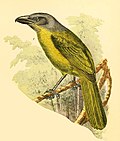| Malaconotus | |
|---|---|
 | |
| Grey-headed bushshrike (Malaconotus blanchoti) in Reichenow (1902) | |
| Scientific classification | |
| Kingdom: | Animalia |
| Phylum: | Chordata |
| Class: | Aves |
| Order: | Passeriformes |
| Family: | Malaconotidae |
| Genus: | Malaconotus Swainson, 1824 |
| Type species | |
| Lanius olivaceus [1] Vieillot, 1818 | |
| Species | |
6, and see text | |
Malaconotus is a genus of passerine birds in the bush-shrike family Malaconotidae, which is endemic to sub-Saharan Africa. Their Greek generic name suggests fluffy back and rump feathers. [2]











